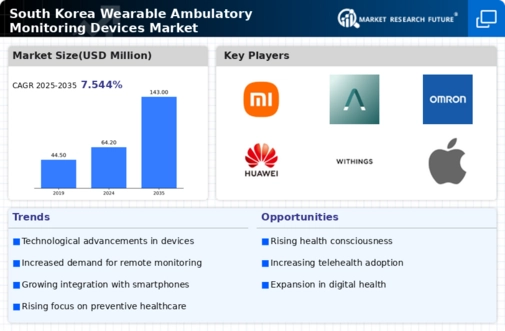Growing Aging Population
South Korea's demographic shift towards an aging population is a crucial driver for the wearable ambulatory-monitoring-devices market. With over 14% of the population aged 65 and older, there is an urgent need for innovative health solutions tailored to the elderly. Wearable devices can play a vital role in monitoring health conditions, ensuring safety, and enhancing the quality of life for older adults. The government has recognized this trend and is investing in technologies that support elderly care, which is likely to stimulate market growth. Additionally, the increasing acceptance of technology among older adults suggests a promising future for wearable devices designed for this demographic. As a result, the wearable ambulatory-monitoring-devices market is expected to see substantial growth driven by the needs of the aging population.
Integration of Artificial Intelligence
The integration of artificial intelligence (AI) into wearable ambulatory-monitoring-devices market is transforming the landscape of health monitoring in South Korea. AI technologies enable devices to analyze vast amounts of health data, providing users with personalized insights and recommendations. This capability enhances the functionality of wearable devices, making them more appealing to consumers. For instance, AI algorithms can predict potential health issues based on historical data, allowing for proactive health management. The market for AI-driven health solutions is projected to grow at a CAGR of over 20% in the coming years, indicating a robust interest in smart health technologies. As consumers become more tech-savvy, the demand for AI-integrated wearables is likely to increase, further propelling the growth of the wearable ambulatory-monitoring-devices market.
Enhanced Connectivity and IoT Integration
The rise of the Internet of Things (IoT) is significantly impacting the wearable ambulatory-monitoring-devices market in South Korea. Enhanced connectivity allows wearable devices to seamlessly integrate with other smart health technologies, creating a comprehensive health monitoring ecosystem. This interconnectedness enables users to access their health data across multiple platforms, improving user experience and engagement. Furthermore, IoT-enabled devices can facilitate real-time communication between patients and healthcare providers, leading to timely interventions and better health outcomes. As the infrastructure for IoT continues to develop in South Korea, the wearable ambulatory-monitoring-devices market is likely to benefit from increased adoption and innovation in connected health solutions.
Rising Demand for Remote Health Monitoring
The increasing prevalence of chronic diseases in South Korea is driving the demand for wearable ambulatory-monitoring-devices market. With conditions such as diabetes and hypertension affecting a significant portion of the population, there is a growing need for continuous health monitoring solutions. According to recent statistics, approximately 30% of adults in South Korea are living with chronic illnesses, which necessitates regular health assessments. This trend is likely to propel the adoption of wearable devices that can track vital signs and provide real-time data to healthcare providers. Furthermore, the convenience of remote monitoring allows patients to manage their health more effectively, potentially reducing hospital visits and healthcare costs. As a result, the wearable ambulatory-monitoring-devices market is expected to expand significantly in response to this rising demand.
Rising Consumer Interest in Preventive Healthcare
There is a notable shift in consumer attitudes towards preventive healthcare in South Korea, which is positively influencing the wearable ambulatory-monitoring-devices market. As individuals become more proactive about their health, they are increasingly seeking tools that enable them to monitor their well-being. This trend is reflected in the growing sales of wearable devices that track fitness metrics, heart rate, and sleep patterns. Market data indicates that the demand for health-focused wearables has surged by approximately 25% in recent years. This heightened interest in preventive measures is likely to drive further innovation in the wearable ambulatory-monitoring-devices market, as manufacturers strive to meet consumer expectations for advanced health monitoring solutions.




















Leave a Comment